Electrons, waves and photons
1/130
There's no tags or description
Looks like no tags are added yet.
Name | Mastery | Learn | Test | Matching | Spaced |
|---|
No study sessions yet.
131 Terms
All electromagnetic waves have the following properties in common:
They are all transverse waves
They can all travel in a vacuum
They all travel at the same speed in a vacuum (free space) — the speed of light
What is speed of light?
Given in booklet
The speed of light in air is approximately the same as in a ______
vacuum
EM waves consist of ___________ ____ _____oscillating at ___ _____ to each other and to the direction in which the wave is travelling
electric and magnetic fields
right angles

all waves in this EM spectrum can (cuz they are transverse):
Reflect
Refract
Diffract
Be polarised
Produce interference patterns
What is order of EM?
Radio waves
Microwaves
Infrared
Visible light
UV
X-ray
Gamma ray
How are EM waves arranged?
longest wavelength to shortest wavelength
Longer wavelength =
Lower E
Low frequency
Short wavelength=
Higher E
High frequency
EM waves diagram

Radio uses
Communication (radio +tv)
Microwave uses
Heat food
Communication (wifi, mobile phones, satellites)
IR uses
Remote controls
Fibre optic communications
Thermal imaging (medicine + industry)
Night vision
Heating/ cooking things
Motion sensors
Visible light uses
Seeing
taking photos and videos
UV uses
security markings (fluorescence)
fluorescent bulbs
getting a sun tan
X-ray uses
X-ray images (medicine, industry and security at airports)
Gamma ray uses
treating cancer
sterilising medical equipment
aprox. wavelength range (m) of radio
>0.1
aprox. wavelength range (m) of micro
0.1- 1×10-³
aprox. wavelength range (m) of IR
1×10-³ - 7X10^-7
aprox. wavelength range (m) of visible
4×10^-7 - 7×10^-7
aprox. wavelength range (m) of UV
4×10^-7 - 1×10^-8
aprox. wavelength range (m) of X-rays
1×10^-8 - 4×10^-13
aprox. wavelength range (m) of gamma rays
1×10^-10 - 1×10^-16
from these values use _____ to work out range of frequencies
c = fλ where c is the speed of light:
Polarisation definition
Particle oscillations occur in only one of direction perpendicular to the direction of wave propagation
Polarisation can only occur in ______ waves
transverse
Why does polarisation can only occur in transverse waves
electromagnetic transverse waves are oscillating electric and magnetic fields in any plane perpendicular to the propagation direction
When transverse waves are polarised, this means:
Vibrations are restricted to one direction
These vibrations are still perpendicular to the direction of propagation / energy transfer
Longitudinal waves (e.g. sound waves) ______ be polarised and why
cannot
because they oscillate parallel to the direction of travel
polariser e.g.
polarising filter (light)
metal grilles (microwaves)
plane-polarised definition
only allows oscillations in a certain plane to be transmitted
why a metal grille is different from a polarising filter
The free electrons moving in the metal bar can cancel out the electric field in the same direction as the grille and completely absorb it
Thus the horizontal electric field passes if the grilles are positioned vertically and vice versa
The resulting graph of the light intensity with angle, as the second polariser is rotated through 360°

When does refraction occur?
Light passes a boundary between two different transparent media, where they change direction
Change in direction depends on which media the light rays pass between
Air to glass (less dense to more dense): light bends towards the normal
Glass to air (more dense to less dense): light bends away from the normal
Along normal, light doesn’t bend at all
More dense= towards normal
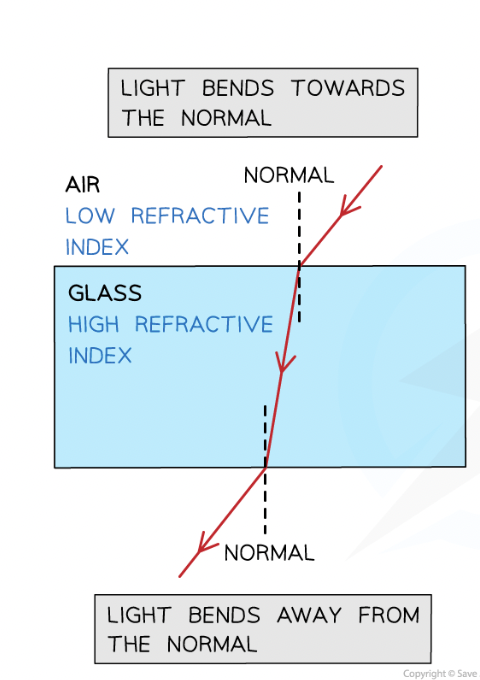
Why does the change in direction occur in refraction?
Change in speed of wave when traveling in different substances (denser substance, rays slow down, hence bend towards the normal)
What changes during refraction?
Change: Speed and wavelength
Doesn’t change: frequency
What is refractive index?
Measure of how much light slows down when passing through it
What n= c/v mean + units
n= the index of refraction
c= speed of light in a vacuum (m/s)
v= speed of light in a substance (m/s)
What is a material with a high refractive index called and make light travel slower/faster?
Optically dense
Slower
What is the refractive index of light and why?
Aprox 1
Cuz light doesn’t slow down significantly when travelling through air as opposed to a vacuum
n will always be greater / less than 1
greater
snell’s law
relates the angle of incidence to angle of refraction (not given in equation sheet)

What symbols mean in snell’s law
n1= refractive index of material 1
n2= refractive index of material 2
θ1= angle of incidence of the ray in material 1
θ2= the angle of refraction of the ray in material 2

When the angle of refraction is exactly ___ the light is refracted along the boundary.
The angle of incidence is known as the _______
90°
critical angle C
Critical angle (given) can be found using and what can it be derived from
Sin(C)=1/n
This can easily be derived from Snell’s law where:
θ1 = C
θ2 = 90°
n1 = n
n2 = 1 (air)
Total internal reflection (TIR) occurs when:
angle of incidence is greater than the critical angle
the incident refractive index n1 is greater than the refractive index of the material at the boundary n2
two conditions for total internal reflection are:
The angle of incidence, θ1 > the critical angle, C
Refractive index n1 > refractive index n2 (air)
How find and draw all the angles

Refraction definition
light travels at a different speed when travelling through another medium
Diffraction definition
spreading out of waves when they pass an obstruction
This obstruction is typically a narrow slit known as an aperture
only property of a wave that changes when it diffracts is _____ and why
amplitude
because some energy is dissipated when a wave is diffracted through a gap
effects of diffraction are most prominent when _______
the gap size is approximately the same or smaller than the wavelength of the wave
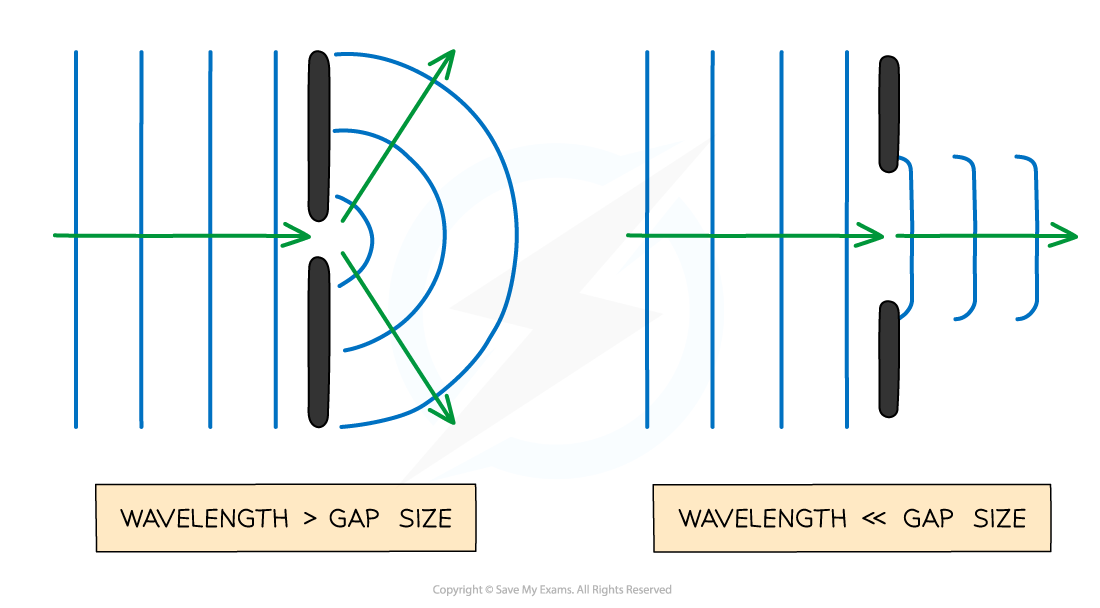
_______ ______ of light can be represented as a series of light and dark fringes which show the areas of maximum and minimum intensity
diffraction pattern
If the laser were to be replaced by a non-laser source emitting white light
The central maximum would be white
All maxima would be composed of a spectrum
The shortest wavelength (violet / blue) would appear nearest to the central maximum
The longest wavelength (red) would appear furthest from the central maximum
The fringe spacing would be smaller and the maxima would be wider
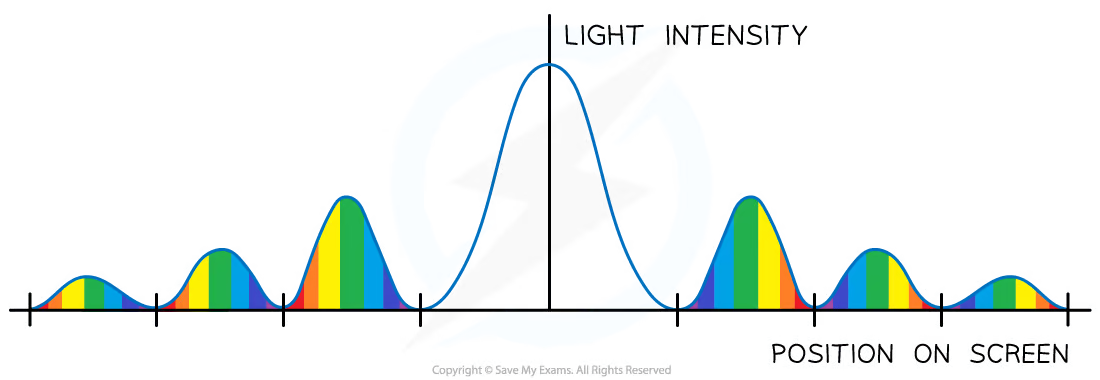
principle of superposition states:
When two or more waves with the same frequency arrived at a point, the resultant displacement is the sum of the displacements of each wave
Superposition in sound e.g.
stationary, longitudinal sound waves in a resonance tube such as in an organ pipe or woodwind instruments such as a flute
Superposition experiments with sound often use what?
air columns or speakers
If two loudspeakers are connected to the same signal generator, the superposition of the sound waves can be heard when walking along in front of the speakers
A loud sound is heard when the sound waves _______
A quiet or no sound is heard when the waves ________
reinforce one another
cancel each other out
The superposition of light waves is demonstrated through:
Young's double-slit experiment
Diffraction grating
in young’s double-slit experiment the light waves are _______ when they reach a screen
what does this show?
superposed
shows an interference pattern
___________ is commonly used for these experiment to produce the clearest interference pattern on the screen
Monochromatic laser light
distance between the maxima and minima on the pattern varies with the _____ of the light
frequency
interference of microwaves creates a ________ inside a microwave oven, which is used to heat food
standing wave
Microwave superposition experiments normally include:
Two microwave transmitters
A microwave detector
To produce a microwave stationary wave, a ______ is often used too, with just one transmitter
microwave reflector
Complete constructive or destructive interference is seen most clearly when the two superposing wave have the ________
same speed, frequency and amplitude
Graphical representation of superposition
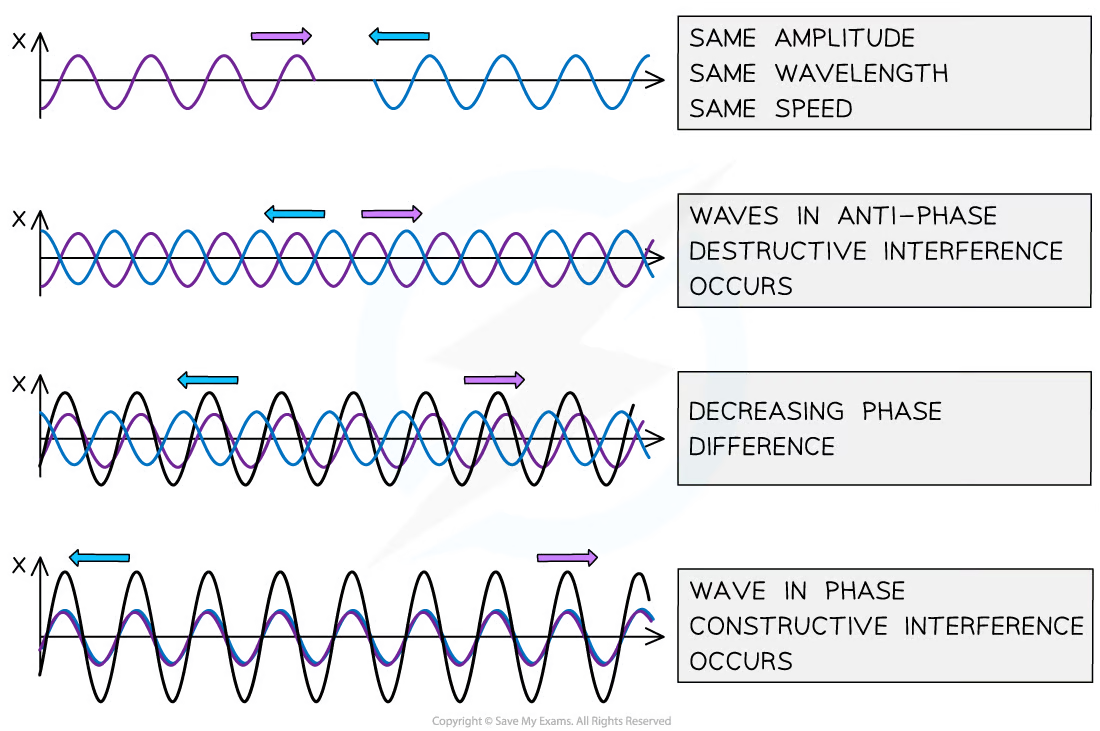
How to find resultant of two waves
The best way to draw the superposition of two waves is to find where the superimposed wave has its maximum and minimum amplitude. It is then a case of joining them up to form the wave. Where the waves intersect determines how much constructive or destructive interference will occur.
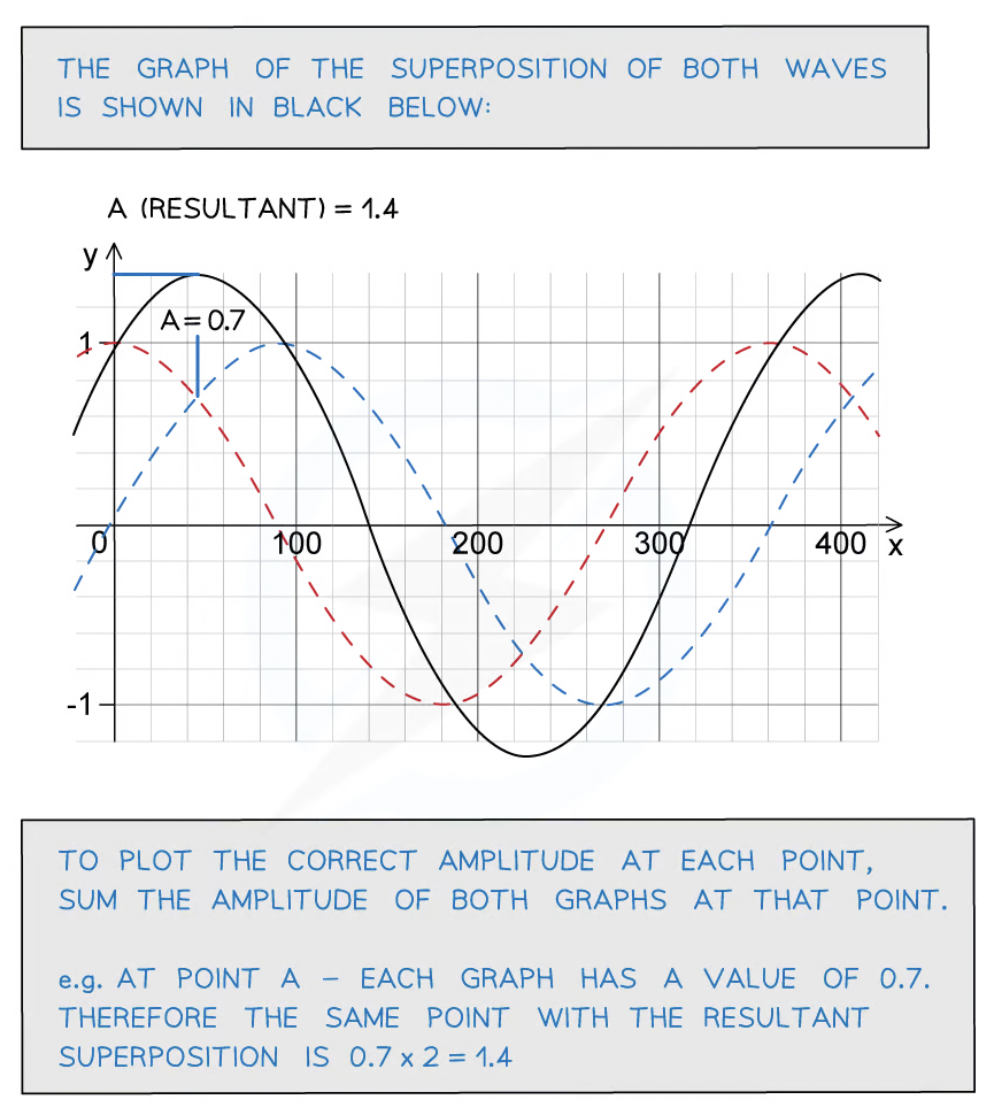
When does interference occur?
when waves overlap and their resultant displacement is the sum of the displacement of each wave
When does constructive interference occur?
When two waves with the same frequency and amplitude arrive at a point in phase
The peaks and troughs line up on both waves and the resultant wave has double the amplitude

When does destructive interference occur?
When two waves with the same frequency and amplitude arrive at a point in anti-phase
The peaks on one wave line up with the troughs of the other. The resultant wave has no amplitude
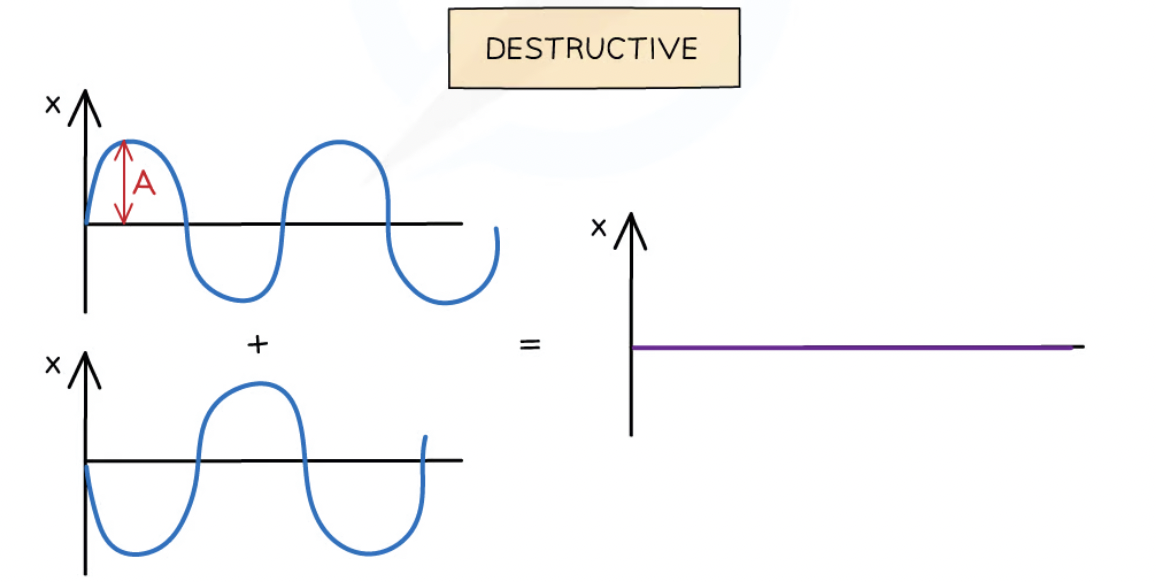
Waves are said to be coherent if they have:
The same frequency
A constant phase difference
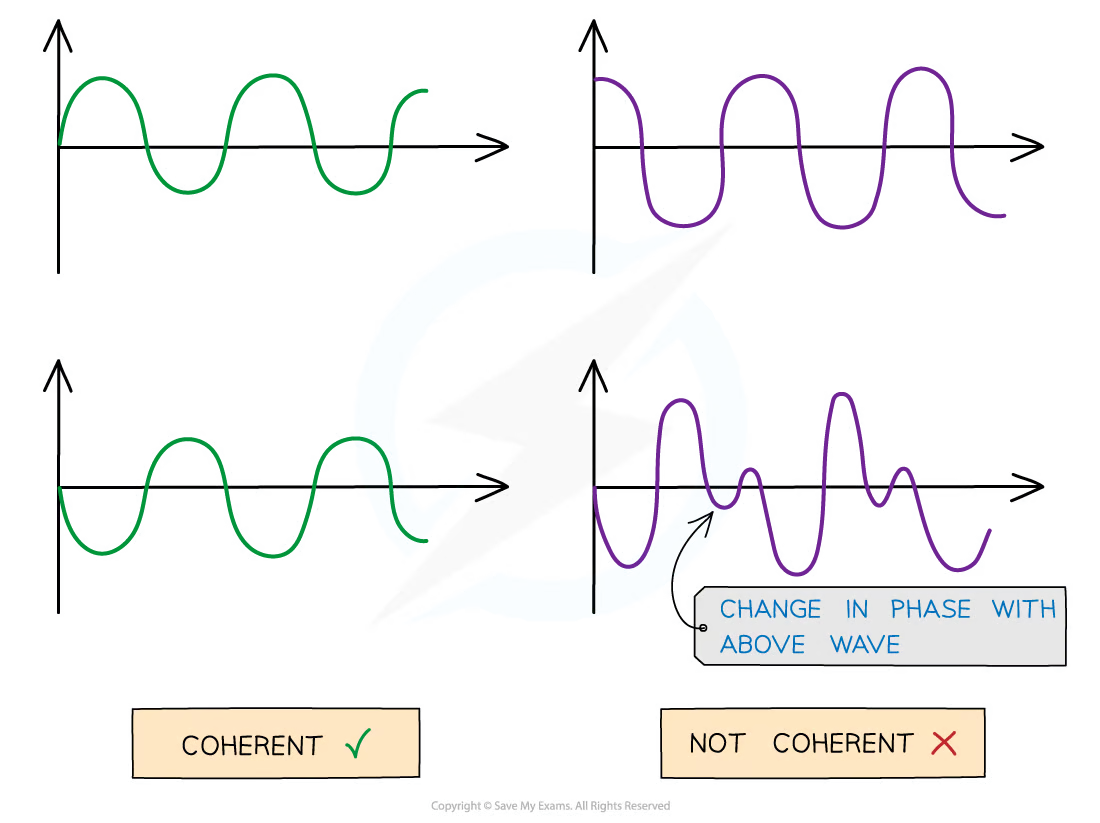
Coherence is vital in order to produce what?
an observable, or hearable, interference pattern
Path difference is defined as:
The difference in distance travelled by two waves from their sources to the point where they meet
Phase difference is defined as and given in what:
The difference in phase between two waves that arrive at the same point
degrees/ radians
Two waves with a path difference will also have a difference in _____
phase
Path difference is determined in ____
multiples of a wavelength
Constructive interference occurs when there is a path difference of __
nλ
Destructive interference occurs when there is a path difference of __
(n + ½)λ
phase difference between two waves is determined by ____
angle, in radians or degrees
Constructive interference occurs when ____
phase difference is an even multiple of π or that they are in phase
Destructive interference occurs when ______
phase difference is an odd multiple of π or that they are in anti-phase
When
In phase, causing constructive interference
what happens?
The peaks and troughs line up on both waves
The resultant wave has double the amplitude
When
In anti-phase, causing destructive interference
The peaks on one wave line up with the troughs of the other
The resultant wave has no amplitude
In two source interference of sound waves when does constructive and destructive interference occur?
Constructive interference occurs when two compressions or two rarefactions line up and the sound appears louder
Destructive interference occurs when a compression lines up with a rarefaction and vice versa. The sound is quieter
When can two source interference for microwaves be detected?
with a moveable microwave detector
When a two source interference of microwaves where does constructive and destructive interference occur?
Constructive interference occurs in regions where the detector picks up a maximum amplitude of the signal
Destructive interference occurs in regions where the detector picks up no signal
For two-source interference fringes to be observed, the sources of the wave must be:
Coherent (constant phase difference)
Monochromatic (single wavelength)
What is the path difference in Young’s double slit experiment
wave from slit S2 has to travel slightly further than that from S1 to reach the same point on the screen
The difference in this distance is the path difference


n is the order of the maxima/minima since there is usually more than one of these produced by the interference pattern
n = 0 is taken from the middle, n = 1 is one either side and so on
What does Young’s double slit experiment show?
how light waves can produce an interference pattern
Set up of young’s double slit experiment
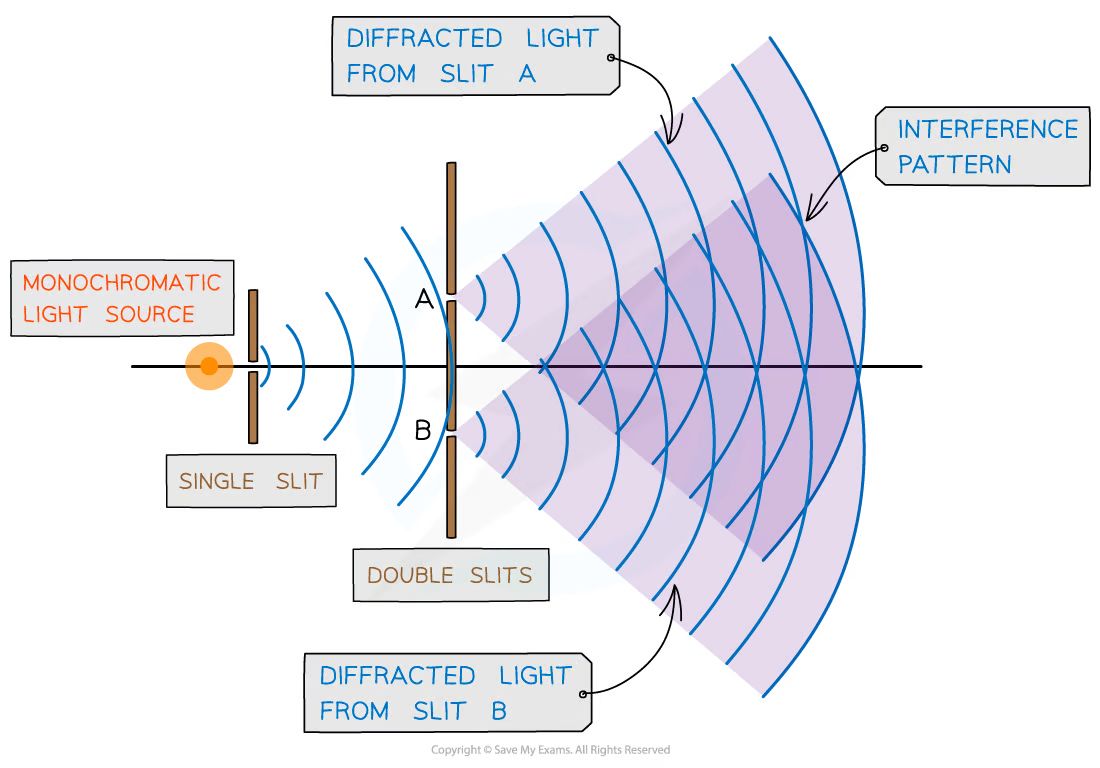
How does young’s double slit experiment work
When a monochromatic light source is placed behind a single slit, the light is diffracted producing two light sources at the double slits A and B
Since both light sources originate from the same primary source, they are coherent and will therefore create an observable interference pattern
Both diffracted light from the double slits create an interference pattern made up of bright and dark fringes
Wave Theory of Light
explains the phenomena of diffraction and refraction
This theory describes light as a series of wavefronts on which every point is a source of waves that spread out and travel at the same speed as the source wave
These are known as Huygens’ wavelets
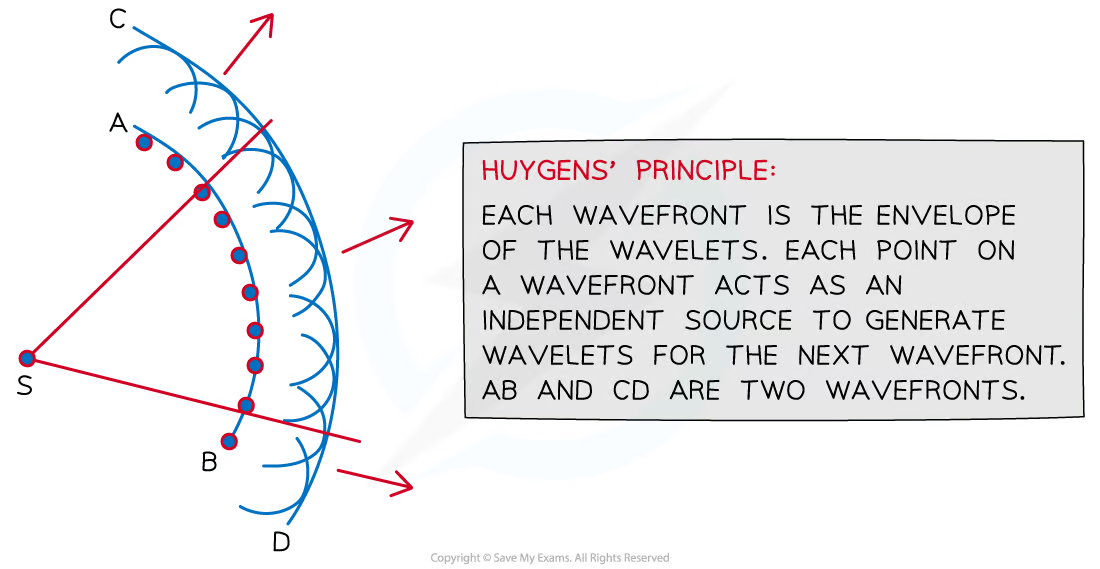
Double slit equation: λ= ax/D
λ= wavelength of source (m)
a= distance between centres of the slit /separation of the two slits.
x= fringe width (distance between successive bright fringes) (m)
D= distance between double slit to the screen (m)
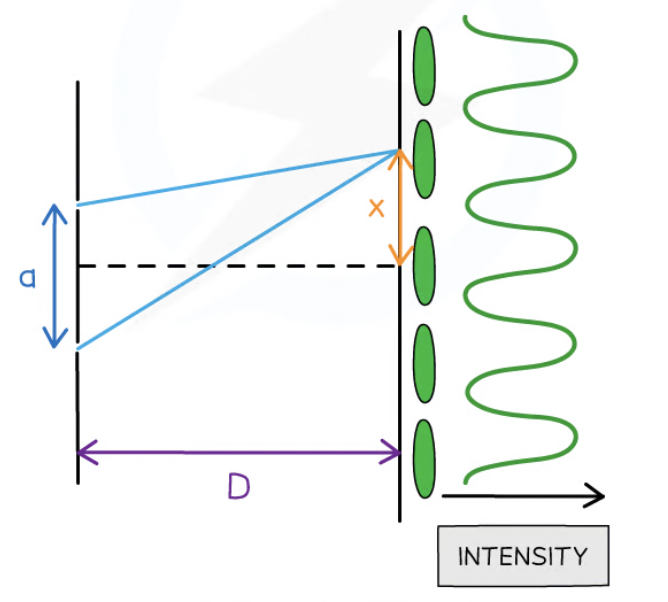
When the double slit equation only work?
a << D
THz to Hz
1×10^12
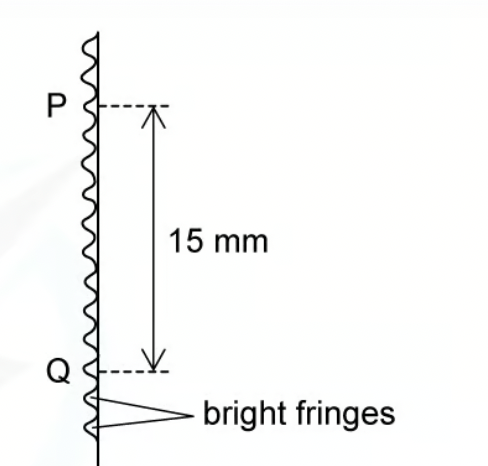
remember when calculating X if looks like
15×10^-3 ➗ 9
(➗ n. of wavelengths)